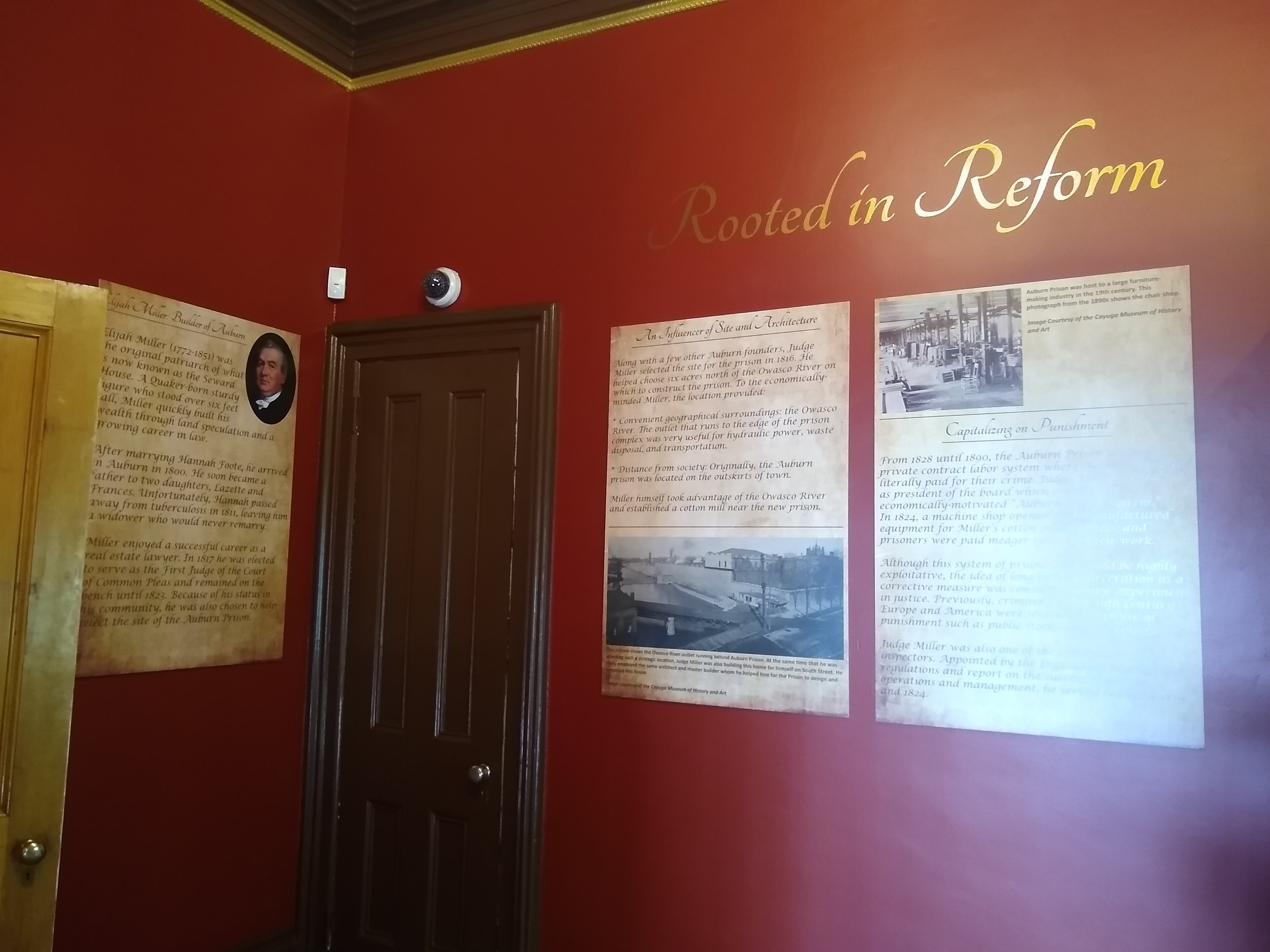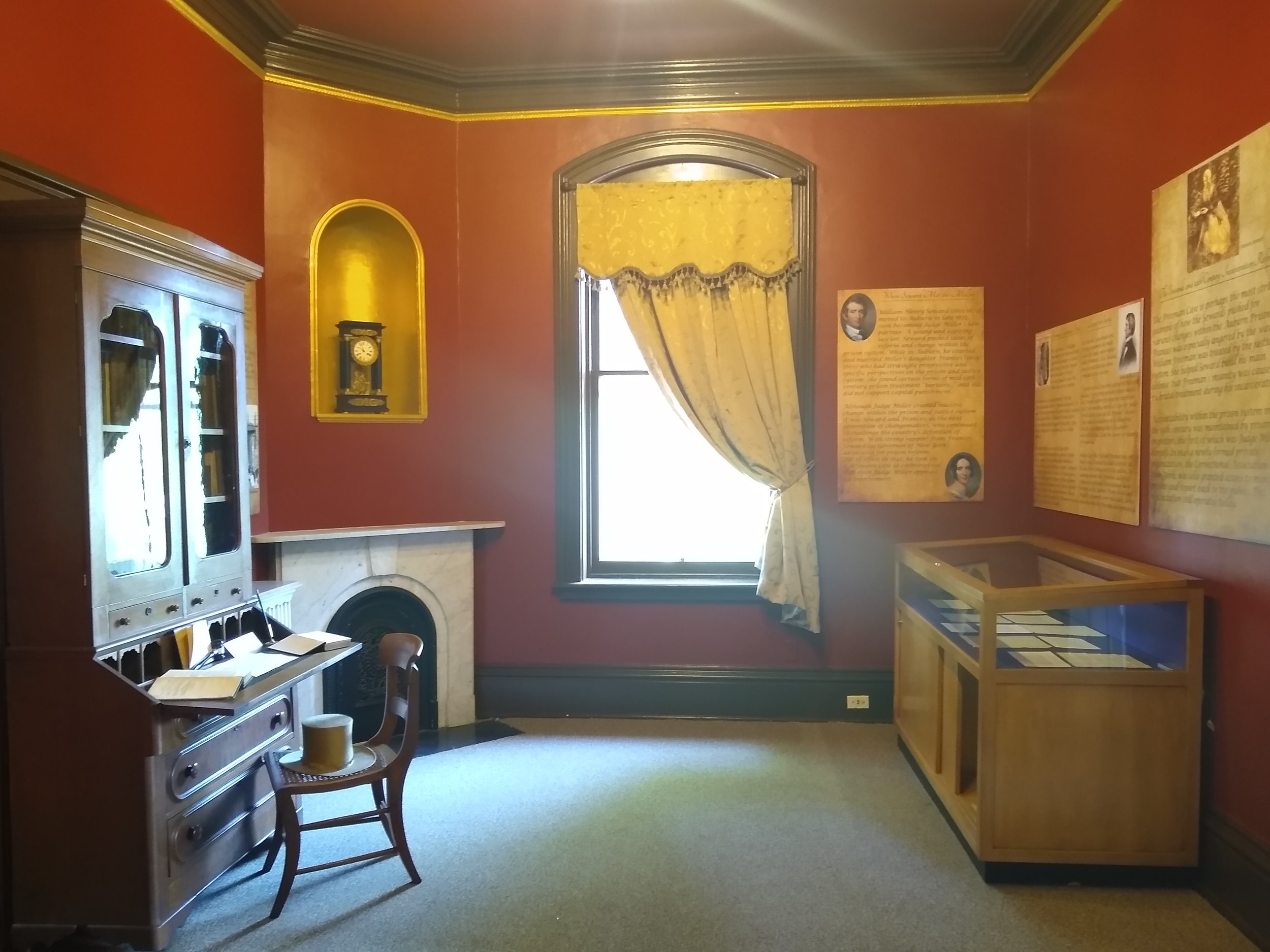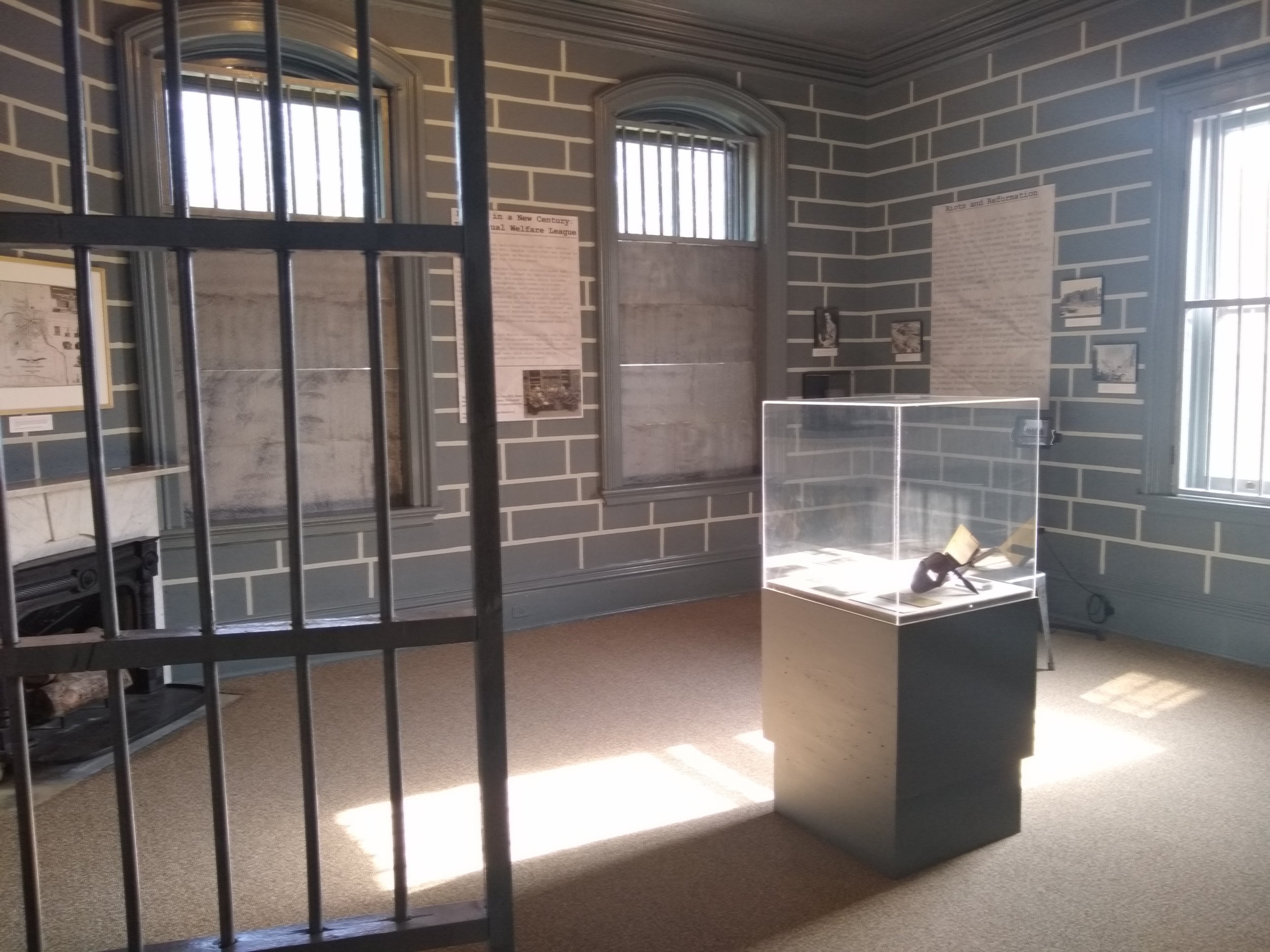A Small Museum on a Big Mission: Exhibiting a Local Story of Carceral Reform to Engage National Audiences
Kate Grindstaff
Citation: Grindstaff, Kate. “A Small Museum on a Big Mission: Exhibiting a Local Story of Carceral Reform to Engage National Audiences” The Coalition of Master’s Scholars on Material Culture, November 17, 2023.
Abstract: The Seward House Museum, home to the progressive Miller/Seward family, with its almost completely original collection of artifacts, strives to tell the story of the socio-political legacy of William H. Seward and Frances Miller Seward. After a decade of steady institutional modification and newly discovered research, the Seward House decided to embark on a difficult exhibition journey– one that discussed the family’s involvement in nineteenth century prison reform. By inviting the local Auburn audience to share their story while exploring national themes and partnerships, Rooted in Reform attempts to make a wide-reaching social impact by focusing on the story of Auburn Prison, now known as Auburn Correctional Facility. Through sensitive research, building new partnerships, and the desire to push traditional museum boundaries, a seemingly local and niche historic house can have the power to approach a national story and engage a national audience.
Keywords: public history, community engagement, house museums, prison reform



Imagine vacationing in the Finger Lakes region of New York. While in the heart of this scenic region, maybe, like many others, you will decide to spend a day visiting the broad range of historic sites in the area. It could be that you will be enticed to take a tour of a mustard yellow brick mansion built in 1816 in Auburn, NY. The Seward House Museum, home to the progressive Miller/Seward family, with its almost completely original collection of artifacts, strives to tell the story of the socio-political legacy of William H. Seward and Frances Miller Seward. Perhaps you anticipate wandering through a pristine layout of Federal and Victorian style rooms. Perhaps you assume you will hear about Seward’s Folly, the Civil War, and Harriet Tubman. However, would you also expect to find an exhibition space dedicated to discussing carceral reform and modern rehabilitation proposals linking twenty-first-century mass incarceration to sentiments of the nineteenth century? Perhaps not. Through sensitive research, building new partnerships, and the desire to push traditional museum boundaries, a seemingly local and niche historic house can have the power to approach a national story and engage a national audience.
Founded in 1951, the Seward House Museum used to be a reflection of traditional historic house values. Over the decades, it steadily morphed into an organization that endeavored to reach both a local and national audience and adapted to industry practices that began emphasizing public service and social justice. After becoming a not-for-profit organization in the mid-2000s, internal structures and interpretations began to transform – no longer was the site only celebrating the political accomplishments of William Henry Seward and discussing his relationship to Abraham Lincoln. No longer was the site simply an explanation of architectural history and the family’s everyday life. Staff began forging connections between family actions and beliefs that mirrored events in the twenty-first century, such as immigration reform, education reform, women’s rights, and racial equality and bias. Alongside access to new information, quicker communication, increased staff and institutional capacity, and changing values within the museum industry, the Seward House evolved into a new age of educational programming and provocative exhibiting. Museum staff completed new archival research, explored new perspectives, and gained new insights. As the depth and significance of the Seward story became increasingly mingled with a broad modern American experience, the vision of the Museum evolved to serve not only a local community, but also a wider audience. However, as many smaller and older museums understand, balancing the needs and services to these often very different audiences can be a major challenge.
After a decade of steady institutional modification and newly discovered research, the Seward House decided to embark on a difficult exhibition journey– one that discussed the family’s involvement in nineteenth century prison reform. The topic of reform within the American prison system is still as hot as it was 200 years ago, and the delicacy of related opinions, experiences, and personal and systemic trauma demands an extremely thoughtful, informed, and safe exhibition space. Within Auburn, this endeavor became even more arduous, as the city is home to the oldest continually running prison in the country: Auburn Prison, or Auburn Correctional Facility, as it is referred to today.[1] Also constructed in 1816, the original prison site was chosen by a small commission that included the patriarch of the Miller/Seward family, Elijah Miller. [2] Miller’s daughter, Frances, and her husband, William Henry Seward, advocated for prison reform as part of a later generation of changemakers. William Henry, with Frances’ support, acted as the defense lawyer for an extremely controversial criminal case in 1846 – the trial of William Freeman. In short, his arguments made in defense of the formerly incarcerated Freeman, a person of color, monumentally advocated for increased racial equality and mental health reform.[3] Building off of these incredible connections to the family, the Seward House decided to create the exhibition, Rooted in Reform, to highlight the local and national significance of the maximum-security Auburn Prison, as well as pose relevant questions about the future of reform in our country.
In the town of Auburn, prison associations and memory are multigenerational. The national influence of the historic institution cannot be overstated. After being constructed as an experiment in withdrawing from the early system of European/colonial corporal punishment,[4] the prison began to be a continuous site of change.[5] Long-term incarceration, profit-based group labor, and solitary confinement, or the Auburn Prison System, became the prototype for American prisons for decades to come.[6] As new generations realized the downsides to many reform or punishment methods, they argued for a new approach. Should capital punishment exist? Frances didn’t think so.[7] Would the use of the electric chair be more humane than the gallows? Seemingly not, after its first use was tested in Auburn around the turn of the twentieth century.[8] Could self-government, artistic and social reward, and education of the incarcerated perhaps aid in rehabilitation? Auburn citizens through the years asked these questions and initiated systemic change through the prison. Many constituents of the Seward House Museum have family members employed at the facility, or at least know somebody who is. Some constituents have family members behind the bars, or at least know somebody who is. After functioning for over 200 years, being a site emblematic of experimental carceral change, and remaining a major economic life force of the community,[9] the Auburn Prison holds heavy weight in local minds. It looms in the center of town, an ever-present reminder of our past and current justice system. Yet, its 40-foot walls can also invite ignorance.[10] How could a museum like the Seward House, which acts as a staple of historic pride for the local community, broach such a complicated topic without alienating part of its audience? How does a small historic house approach the idea of creating both a locally and nationally relevant exhibit?
As the Education and Outreach Coordinator and main contributing researcher for Rooted in Reform,[11] this was my question to ponder. In the beginning, I was tasked with extensively researching the exhibit topic and developing the first draft of interpretive panels. It must be stated that I had no prior education about or experience interpreting carceral systems, and I was not native to the area. Although I was incredibly interested in creating a thoughtful and powerful exhibit, I knew nothing of the Auburn Prison and its relationship to the local community nor its national significance. I was not exactly well-positioned to generate a cutting-edge interpretation over the span of a couple months, but I embraced the challenge, nonetheless. My process began by widely researching the overall significance of Auburn Prison through local resources and history books. After feeling as though I had a base-level knowledge of the prison’s importance, I delved deeper into academic articles critiquing the history of the United States’ penal systems and specific reform measures that the Miller/Seward family was involved in. I scoured biography notes, read through family letters, and sifted through details of the monumental Freeman trial. Although I learned an abundance of information, from which I built our base exhibit content, the most fascinating element of the research journey was the difference in and strength of local opinions. The museum initially feared some backlash over the exhibit, and that fear was somewhat well-based.
From the beginning of the exhibit’s proposal, doubt hovered over how the topic would be handled. While industry interests leaned liberally towards fighting for carceral reform, many local community members with direct prison experiences worried about whether the correctional officer/administrative perspective would be overlooked or even forgotten. Even within the Seward House itself, staff and volunteers who were native to the area cringed at the liberal bent of the proposed interpretation. Realizing the sensitive nature of the subject, I took the job of gathering local opinion seriously and with an open mind. I recognized that there was a lot that I didn’t know or understand, and my personal experience would never fully align with either the museum’s main or targeted audience. Rather than deeply analyzing the historic context of the facts that I read, I made a major part of my research revolve around gathering as many local perspectives as possible and presenting them in a way that could not only accurately reflect historical fact but also limit the effect of visitor bias and political animosity. I discussed staff fears and concerns during personal meetings. I asked our local volunteer base what they would like to see acknowledged in our exhibit. I interviewed a former Captain of the Auburn Correctional Facility as well as a university professor who facilitated artistic rehabilitative programming behind prison walls. I tried to collect as many local perspectives as possible and realized that we would need to spend more time delving into the testimonies and viewpoints of the formerly incarcerated and their families in the future. The common local response, which I found intriguing and surprising, was the direct wariness and suspicion over the purpose of the exhibit. While most agreed the topic needed to be discussed, many feared the discussion would prioritize needed improvements for the incarcerated community while demonizing and negating decades of commitment from the correctional staff. I began to become rather frustrated at this response, as it seemed everyone already assumed what I believed and that my personal political point of view would be guiding the exhibit’s interpretation. I found myself trying to gather perspective but also receiving bias of all sorts. I began going down a rabbit hole of choosing the most sensitive phrases and terminology, questioning what I understood fact and accurate sourcing to be, and deeply feeling the cynicism and hopelessness of the topic. I became inundated with emotional storylines and horrified at some of the actions taken within our justice system that I had previously been ignorant of. The project consumed me, and I finally began to understand the depth of the topic I had been tasked to interpret.
When it came time to edit my interpretive panel drafts, I had developed strong feelings on certain elements that I believed shouldn’t be cut. First, to meet the needs of our local visitor audience, an apolitical perspective would need to be emphasized. I believed a statement of intent needed to be written, to encourage our local visitors to engage with the exhibit. Initially, I included assorted assertions and provocative questions about the nature of bias and human nature related to managing a safe society, although those were mostly cut due to unnecessary personal analysis and length. Ultimately, the final product, opened in May 2023, was a direct interpretive response to local perspective and needs.
Before the research journey began, museum leadership knew this exhibit would discuss far too much information to be adequately defined in the limited space allocated. Thus, the Seward House strategically planned its exhibit to have multiple renditions. To properly explore such a wide topic, care and continued research needed to be developed and added over the lifetime of the exhibit. After the first, heavily localized version was executed, what needed to occur to reach and be relevant to a wider audience was clear: the Seward House needed more support. Dr. Jeff Ludwig, the Director of Education, ventured into new waters and initiated introductions to larger state and national organizations and museums that regularly dealt with carceral justice and prison interpretation. He wrote a grant (that we hope to receive!) to finance staff development and training experiences related to incarceration interpretation to aid us in becoming more aware and informed. Through the development of new partnerships with qualified organizations like the Correctional Association of New York, the Seward House is now preparing to enhance Rooted in Reform to be of a quality even more worthy of national attention. Besides connecting with and teaching the staff of the Seward House, partner organizations will also help to inspire and initiate consistent programming for different audiences. Dr. Ludwig and Billye Chabot, the Executive Director of the Seward House, also proposed a panel to be presented during the Museum Association of New York’s annual conference. The panel utilized new partner relationships and discussed the journey of a small house museum on a big social justice mission. The power of partnership and knowledge sharing cannot be emphasized enough, especially in the context of Rooted in Reform. Through these influential partnerships, wide-reaching conferences, continued local influence, and broad topic relevance, the Seward House aspires to raise a national viewership. To be clear, Rooted in Reform’s journey is definitely still in progress and there are many improvements and connections yet to be made.
To answer the impending critical question of why the Seward House chose to take on this endless debate of a topic, the first version of Rooted d on thin Reform mainly focused direct historical connections between the Miller/Seward family and Auburn Prison. Museum leadership also emphasized the role of changemaking and boundary-pushing the Seward family epitomized to justify the institution’s social justice endeavor. In later renditions, the museum will elaborate more deeply on racism within the justice system and its historical foundations. The future Rooted in Reform aims to collect testimonies and opinions from people directly related to the prison system on both sides of the bars. Resources will be distributed to visitors, specifically those that aid correctional officers and prison staff, their families, the incarcerated and formerly incarcerated, and their families. The exhibit will also continue to offer interactive elements through which visitors can express their thoughts while engaging with historical connections and guiding questions. By designing the exhibit to be more dialogical, open-ended, and grounded in local stories, Rooted in Reform will continue working towards meeting the needs of its varying audiences.
It can be argued that a museum like the Seward House does not have the capacity to manage an exhibition as all-encompassing as Rooted in Reform. However, it certainly has the capacity to connect nineteenth century history directly to issues of the modern day, and it has incredibly direct connections to reform within the Auburn Prison. Is it a topic that strays from traditional historic house interpretation? Yes. Is it a topic that can be political and volatile? Yes. Is it a topic that needs to be discussed and is relevant to the intended local and national audience, while also fitting within the mission of the museum? Also, yes. With this in mind, why don’t we embrace the challenge, address our positionality, and relish the social discourse? By inviting our local audience to share their story while exploring national themes and partnerships, Rooted in Reform attempts to make a wide-reaching social impact. Never underestimate the power of history and how its study, even in very specific formats, can inform our understanding of the world today.
Endnotes
[1] Eileen McHugh and Michael Pettigrass, Images of America: Auburn Correctional Facility (Charleston,
South Carolina: Arcadia Publishing, 2010), 8.
[2] Biographical materials, circa 1804-1846, Box 6, Folders 1 & 7, Elijah Miller papers, A.M63, Rare Books, Special Collections, and Preservation, River Campus Libraries, University of Rochester.
[3] Paul Harris, “1. The Black Rage Defense, 1846: The Trial of William Freeman.” In Black Rage Confronts the Law (New York, USA: New York University Press, 1997), 16-17.
[4] For more on documenting early American prison experiments see Katie Thorsteinson’s excellent introduction to Cornell University’s Prison Reform Collection, on which I have relied heavily: “19th Century Prison Reform Collection - Cornell University,” 19th Century Prison Reform Collection, 2017, https://digital.library.cornell.edu/collections/prison-reform.
[5] Eileen McHugh and Michael Pettigrass, 8.
[6] Thorsteinson, “19th Century Prison Reform Collection.”
[7] Letter from Frances to Augustus Seward, 25 June, 1846, Seward Family Digital Archive, Digital Scholarship Lab and River Campus Libraries at the University of Rochester. https://sewardproject.org/18460625FMS_AHS1.
[8] Eileen McHugh and Michael Pettigrass, 9.
[9] Eileen McHugh and Michael Pettigrass, 121.
[10] Eileen McHugh and Michael Pettigrass, 122.
[11] Kate Grindstaff drafted the entirety of the interpretive panel drafts for Rooted In Reform. Edits were made by Jeff Ludwig, Billye Chabot, Emma Dailey and Maria Coleman. Input from other staff, including Alyssa Morris and Mitch Maniccia, were considered.
Bibliography
Elijah Miller papers, A.M63, Rare Books, Special Collections, and Preservation, River Campus Libraries, University of Rochester.
Harris, Paul. "1. The Black Rage Defense, 1846: The Trial of William Freeman" In Black Rage Confronts the Law, 9-30. New York, USA: New York University Press, 1997. https://doi.org/10.18574/nyu/9780814744765.003.0005
McHugh, Eileen, and Michael Pettigrass. Images of America: Auburn Correctional Facility. Charleston, South Carolina: Arcadia Publishing, 2010.
Seward, Frances. Seward Family Digital Archive, Digital Scholarship Lab and River Campus Libraries at the University of Rochester.
Thorsteinson, Katie. “19th Century Prison Reform Collection - Cornell University.” 19th Century Prison Reform Collection, 2017. https://digital.library.cornell.edu/collections/prison-reform.